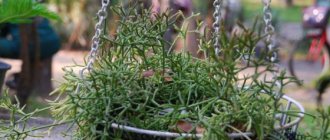Description of indoor chrysanthemum
Chrysanthemums are grown not only in the flowerbed, but also in the room. Flowers grow on the balcony, windowsill. The domestic one is usually miniature, from 15 to 70 cm.
Its shoots are smooth and meet with pile. The inflorescence is a basket of petals. The diameter of the buds is 2.5-5 cm. It blooms in August and blooms until late autumn. The leaves are arranged alternately, differ in size and shape: jagged, notched, dissected, light green in color. The rhizome is branched and develops parallel to the ground.
The bush chrysanthemum in a pot is popular among flower growers; there are species with single petals, reminiscent of daisies, and flowers like a ball. For hanging cultivation there are chrysanthemums in the form of a cascade.
Korean, Indian, and Chinese varieties are common. The color of the flowers is white, orange, lilac, pink. The color in the middle is different from the petals at the edges.
When purchasing in a store, pay attention to the presence of stains, damage, and inclusions. Such a flower should not be taken, just like one that has blossomed. Its leaves should be green, the roots should be strong, the bush should be formed.
Useful tips
Experienced flower growers always have several secrets that help them grow luxurious chrysanthemums. They will be useful to anyone who is going to replant a bush on their site:
- If you purchase a variety in the fall whose frost resistance is unknown, then it is better to transplant the chrysanthemum into a pot for the winter. The plant will survive well for several months in the basement, and in the spring it can be planted outside. You should do the same with a chrysanthemum purchased in a pot in the fall. The bush will not have time to take root before winter and may die. Before sending to the basement, you need to cut the stems to a height of 15 cm and wrap the container in fabric. This will protect the crop from premature germination. In spring, move to a bright and warm place, wait for shoots to appear and replant.
When keeping a garden plant in a pot, it is necessary to trim the stems - When transplanting tall chrysanthemums, you need to immediately take care of support.
- The culture reproduces well from cuttings. If for some reason it was not possible to transplant a chrysanthemum from the street, you can plant a cutting.
- Before applying, the infusion of chicken manure must be diluted with water in a ratio of 1:10.
- Chrysanthemums should be replanted regularly, otherwise flowering becomes unattractive due to the flowers becoming smaller.
- In the hot season, it is recommended to spray the plant with water. Especially if it grows in a room.
Simple tips will help even novice gardeners grow luxurious chrysanthemums.
Classification of chrysanthemums
Plants are classified as follows:
- Sizes: large-flowered and small-flowered (less than 80 cm).
- According to the shape of the inflorescences: double, blanket, non-double, double-row, pinnate, bristly, anemoid.
- Flowering dates: early, mid, late flowering.
- Stem height: tall (45-60), medium (30-45 cm), short (15-30 cm).
- Flower shape: chamomile, spherical.
Popular varieties for growing at home
There are more than 40 varieties of indoor chrysanthemum, including Indian, Chinese (mulberry), and Korean.
| Variety | Peculiarities | Flowers |
| Golden Gloria | Compact, blooms profusely. | Yellow. |
| Lelia | Medium height up to 50 cm. | Terry, dark crimson. |
| Hazell | Bush up to 50 cm. | Spoon-shaped, orange petals. |
| Orange Jam | Ball-shaped, Korean. | Bright orange. |
| Zembla mix | Large buds and tall shoots. | They bloom in autumn, some are green in the middle, different colors. |
| Aurora | Tall, medium-sized inflorescences. | Orange. |
| Snow Elf | Tall stems. | Terry, white. |
| Fantasy | Bush up to 20 cm. | Hot pink, terry. |
| Pink Cascade | Falling shoots are placed in hanging flowerpots. | Pink. |
| Meridian | Low-growing, spherical, leaves are not visible under the blossoming petals. | Semi-double, burgundy, yellow in the middle. |
| apple blossom | The bush is lush, grows up to 0.5 meters. | Terry, pink. |
| Okishor | Up to 50 cm high, large inflorescences 6-8 cm in diameter. | Lilac. |
| Flamingo | Hemispherical, erect bush, inflorescences up to 7 cm in diameter. | Light pink with pearl shimmer. |
| Mascot | Lush, small bush up to 25 cm. | Raspberry. |
| Dune | Grows up to 50 cm. Changes color during flowering. | Bright, yellow-brown. |
| First snow | Up to 35 cm tall, voluminous bush. | White. |
| Malchish-Kibalchish | More than 50 cm high and about 60 wide. | Red, purple. |
Caring for indoor chrysanthemum
To achieve flowering, you should provide appropriate care at home: light, temperature, watering, regularly spraying, feeding the plant.
| Factor | Summer | Spring/Autumn | Winter |
| Location, lighting | Eastern, western window sills. Daylight hours are from 7 to 10 hours. | Dark room. | |
| Temperature | +20…+23 °С. | +15…+18 °С. | +3…+8 °С. |
| Watering | In the evening, twice a week with warm, settled water after the soil has dried. | Once a week. | |
| Humidity | High, you need to spray the leaves and humidify the air. | Need not. | |
| Top dressing | From mid-August with potassium and phosphorus fertilizers. | In spring with nitrogen, once every 12 days. In autumn, phosphorus and potassium. | Not required. |
Why doesn't chrysanthemum bloom?
Any chrysanthemum should bloom in the fall. This law can only be violated if there are errors in caring for the plant. The most common of them are:
- Poor illumination (low intensity of light rays, too long or, conversely, short (less than 7 hours) daylight hours).
- Late pruning (pinching).
- Poor soil and lack of fertilizing (containing phosphorus and potassium).
Eliminate the errors found and your potted chrysanthemum will definitely thank you with lush and long flowering.
How to replant a chrysanthemum
Young bushes are replanted annually, adults once every 2-3 years, usually in March. Select a pot with drainage holes that is 2 cm wider and 1.5 liters deeper than the previous one. Ceramic or clay would be better.
For soil, mix garden soil, humus, peat, coarse sand 3:1:1:1. Disinfect the soil (with boiling water with manganese or in the oven). You can buy ready-made ones at a flowering store. Expanded clay or vermiculite is placed at the bottom, or broken brick can be used. The whole bush is replanted by transshipment or divided into small ones.
When to plant chrysanthemums from a pot. Where and how to plant tsetas
In order for the chrysanthemum to winter well, place it only in a sunny place where moisture does not stagnate. Wetting of the roots is one of the reasons for the death of the plant. Many gardeners notice: where the spring waters stand in the garden, not a single chrysanthemum survives. Therefore, landing on small elevations or hills is allowed.
Flower beds or rockeries with chrysanthemums enliven the garden in autumn
The Queen of Autumn loves neutral and slightly acidic fertile soils. Before planting, it is advisable to dig up poor soil with the addition of 2 kg of mature humus or compost and 1 tbsp. l. superphosphate per 1 m2. If there is no rotted organic matter, add 1-2 tbsp to the soil. l. nitroammophoska per 1 m2. If necessary, heavy soils are lightened with sand.
Superphosphate fertilizer is necessary for abundant flowering of chrysanthemums
It is better to plant chrysanthemums in the evening or in cloudy weather. In order for the roots to develop freely, a sufficient distance between plants is required: 30–50 cm, depending on the size of the bush.
Step-by-step instructions for planting chrysanthemums:
- Before planting, soak the roots of the plant for 1 hour in a solution of humates, Kornevin or another rooting agent according to the instructions.
- Dig a hole 35–40 cm deep.
- To improve the drainage properties of the soil, pour three handfuls of coarse sand onto the bottom and mix with the soil.
- Place the bush in the hole and spread the roots evenly to the sides.
- Sprinkle the plant up to the first leaves with a mixture of soil and old humus, if the area has not been fertilized before.
- Compact the soil around the seedling and water thoroughly.
- Sprinkle the tree trunk circle with a thin layer of compost, old manure or peat.
- Without pity, prune the flowering stems above the bud so that only 5 cm of stumps remain.
For quick rooting in hot weather, shade the bushes with agrofibre. Water them only at the roots as the soil dries out.
Kornevin - stimulator of plant root system formation
Korean chrysanthemums live longer when replanted annually.
How to stimulate chrysanthemum flowering
It is important to follow several rules so that the plant blooms faster:
- Water abundantly, not allowing the soil to dry out.
- Make 12 hours of daylight.
- During the formation of buds, the plant should stand in a cool place + 13 ... + 16 ° C.
- While the buds are small, remove the small ones, leaving only the large ones.
- When all the buds open, provide good lighting.
- Transplant into a spacious container.
- Fertilize with nitrogen before flowering.
Main problems when growing
During the growing season of plants in apartment conditions, gardeners are faced with various problems; let’s consider the main ones.
Why do the leaves turn yellow?
If replanting after purchase was not accompanied by proper care of the crop, yellowing of the leaves of the flower can be observed.
This unpleasant phenomenon is associated with a lack of lighting, lack of moisture in the nutrient substrate or hot air in the room .
Sometimes the cause of leaf discoloration can be a fungal infection.
To prevent drying out, you need to take into account all these nuances.
Why doesn't chrysanthemum bloom?
The lack of flowering on a crop in most cases occurs due to a deficiency or excess of natural light.
It should be taken into account that chrysanthemum is considered a short-day crop. When lighting devices are turned on in the morning and evening, the biorhythms of the flower are disrupted. Another reason why chrysanthemum does not bloom is excessive feeding.
Propagating chrysanthemums in a pot
It is recommended to propagate chrysanthemums by cuttings, dividing the bush, and rarely by seeds.
After reaching three years of age, at the end of summer the bush is dug up, trying not to damage the roots. Cut off old shoots. The shoots are planted.
Cuttings of chrysanthemums in the fall at home
A month before the procedure, after a period of rest, in the spring the pot is transferred to a warm place, where +10…+12 °C. When 4-6 leaves are formed, cuttings are carried out. The soil is prepared from humus, garden soil and sand (1: 2: 0.5), with 2-3 cm of sand on top. Cut cuttings 8 cm long and dip in Heteroauxin, Kornevin. Plant 1.5 cm deep in a container with soil. Cover with film and place in a place with a temperature of +17…+20 °C. Moisturize regularly. After 2 weeks, after rooting, they are planted in pots. Cuttings are also used from a bouquet.
Cuttings in the fall differ in that shoots growing from the mother rhizome are used. Then the plant will bloom in April.
Step by step steps:
- Choose a mother bush.
- Cut off the top part at the root.
- Wait until the basal shoots appear and grow 8 cm.
- Dig up the bush and place it in a bowl with a nutrient mixture.
- Keep for 3 weeks at a temperature of +5…+7 °C. (in the greenhouse, basement).
- Water moderately.
- When young shoots with 2-3 internodes are formed, they are dug out from the mother bush and planted in the soil.
Seeds
Rarely reproduced. They buy it in a store, place it in the soil, sprinkle it with sand, and cover it with film. The soil is periodically moistened. The first shoots appear after two weeks. When three leaves are formed, they are planted separately.
Flower transplant
The procedure itself is not complicated and will take very little time. The only thing that may cause difficulties is the rhizome. He needs to inflict minimal damage.
How to properly replant an indoor chrysanthemum:
- Water the soil in the pot and give the soil time to completely soak. This will make it easier to remove the plant.
- If the container is plastic, you can slightly squeeze it on the sides so that the earthen lump falls away and creates a gap. You will have to work hard with a ceramic product. You will need a flat tool, which is carried along the edge, to the entire depth, for the same purpose - to separate the substrate from the container.
- Carefully remove the plant along with the soil.
- With a highly developed root system, you need to try to remove as much soil as possible without damaging the tendrils. There will be no such problem with young animals; their underground part is poorly developed.
- Pour freshly prepared substrate onto the drainage layer laid out in the new pot.
- Plant the chrysanthemum, add the missing amount of soil and tamp lightly. Add more filler if necessary.
- It is good to water the plant with settled soft water at room temperature.
Now the pot with the transplanted flower can be placed again in its previous “place of residence”.
Diseases and pests
The delicate flower is easily susceptible to diseases and pests.
| Manifestation on leaves | Cause | Corrective measures |
| Gray and fluffy coating. | Gray rot. | The following drugs are used: Topsin-M, Fundazol. |
| Dried underneath with yellow and red spots. | Septoria. | Infected leaves are cut off and destroyed and treated with copper oxychloride. |
| Gray coating. | Powdery mildew. | Spray with Bordeaux mixture, Topaz, Sling. |
| Pale spots above, orange below. | Rust. | They use copper oxychloride, Abiga-Pik. |
| Yellow, flaccid, shoots die, roots are affected. | Verticillium. | Treated with Glyocladin, Trichodermin, transplanted. |
| They wither, turn yellow, fall off. | Fungus in the soil. | The affected parts are cut off and replanted in new soil with a pH of 6.5-7. |
| Small spots. | Mosaic. | The diseased ones are cut and replanted. |
| Yellow-brown spots dry out and fall off. | Nematode. | The affected parts are removed, replanted, and treated with insecticides. |
| The buds curl, become deformed, and do not open. | Aphid. | Treated with Actellik, Fitoverm. |
| Light dots on the lower part, gray-brown on top. | Thrips. | Intavir, Decis are used for treatment. |
| Pale yellow with white spots. | Spider mite. | Treat with a weak soap solution, Fufan, Fitoverm. |
When can you feed
After transplantation, the first feeding will be required only after a month. Banana peel infusions and store-bought organic fertilizers are excellent for chrysanthemum nutrition.
Anything that feeds other indoor flowers will not harm the chrysanthemum. Infusion of onion peels, egg water, dry, crushed peels of bananas and apples - chrysanthemum accepts everything with gratitude. The main thing is to avoid fanaticism. We water as the soil dries out, and feed once a month. This is more than enough.
No fertilizers or top dressing are added to dry soil. All nutrients should be worked or poured into moist soil. Otherwise, there is a risk of burning the roots or damaging the plant at the very roots.
Mr. Summer resident recommends: chrysanthemum immunity protector
Chrysanthemum has many beneficial properties. It contains phytocides, they purify the air from harmful substances and gases. When inhaling the aroma of a flower, a person calms down, thus the plant helps relieve stress.
The flowers contain essential oil that strengthens the immune system and stimulates the body's defenses, antioxidants, vitamins, chrysanthemum tea treats colds and coughs. To normalize sleep, you need to chew several chrysanthemum petals.
In Japan, the flower is a symbol of longevity and happiness; its image is present on the imperial seal. According to the signs of eastern countries, if you carry it with you, it means success in love, and when a girl takes a bath with petals, she will become very attractive to a man.
When can you replant a chrysanthemum after purchase?
Since our chrysanthemum was bought at the very beginning of spring, it was decided not to touch it until it had bloomed. The fact is that there was a sad experience when a flowering plant, after transplantation, dropped everything and died.
The beauty ended after a month and a half. At this time, it was only watered, being careful not to overwater or dry out the plant. The purchased container has large diameter drainage holes, so water could not stagnate. But it’s quite possible to dry.
So, the chrysanthemum flourished safely until mid-April and, at the same time, did not dry out or get sick. Already good. All that remains is to trim it and remove suspicious leaves and twigs. The fact that the transplant was delayed was shown by the leaves drying out at the edges. It was impossible to wait any longer.











